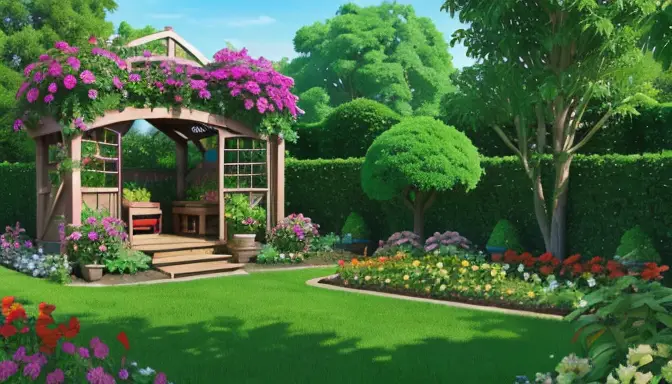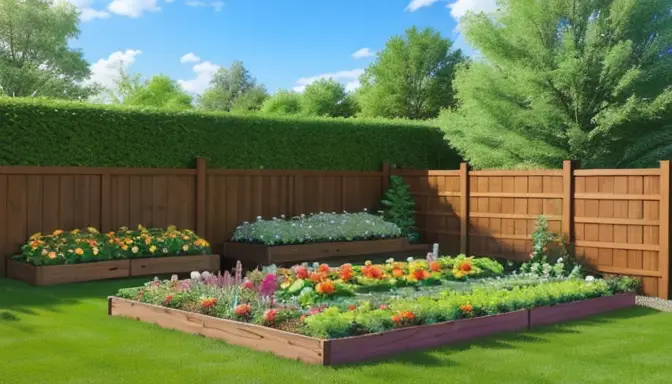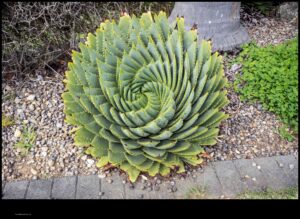As a botanist and horticulturist, it’s vital to acknowledge that dogs are naturally curious creatures .
Remember, a dog’s nose knows no boundaries, so be prepared for some unexpected floral rearrangements in your garden!Their playful nature can lead them to explore and sometimes dig in your garden beds, potentially causing damage to your precious plants..
Selecting the appropriate raised bed design can play a significant role in deterring your furry friends from trampling your garden . Opt for taller beds that are challenging for dogs to reach or consider adding barriers like fences or trellises around the beds. Think of it as creating a botanical fortress that even the most determined dog would struggle to breach.
Strategic planting can act as a natural deterrent for dogs . Incorporate plants with strong scents like lavender or citronella around the perimeter of your raised beds to discourage dogs from getting too close. Additionally, placing prickly plants like rosemary can help keep them at bay. Remember, a well-landscaped garden is like a puzzle, with each plant playing a crucial role in the bigger picture.
Incorporating natural repellents like citrus peels or vinegar can help discourage dogs from approaching your raised beds . You can also consider installing motion-activated sprinklers or ultrasonic devices that emit sounds unpleasant to dogs, keeping them away from your garden. It’s like setting up a botanical force field to protect your green kingdom from unwanted intruders.

To redirect your dog’s attention away from your raised beds, designate a separate area in your garden specifically for them .
Think of it as creating a botanical paradise for your furry companion, where they can frolic and play to their heart’s content.Fill this space with dog-friendly plants and toys to keep them entertained and less likely to venture into your main garden area..
Training your dog to respect boundaries and obey commands is crucial in maintaining a harmonious relationship between your garden and your furry friend . Use positive reinforcement techniques and rewards to encourage good behavior around the garden beds. Remember, a well-trained dog is like a well-pruned plant – both require patience and nurturing to flourish.
Regularly supervising your dog’s outdoor activities can help prevent any potential garden mishaps ️♂️.
Think of yourself as the garden guardian, protecting your botanical treasures from any four-legged threats that may arise.By keeping an eye on them while they are in the garden, you can quickly intervene if they show interest in your raised beds, ensuring the safety of your plants..
If despite your efforts, your dog continues to be a persistent gardener, don’t hesitate to seek advice from a professional dog trainer or behaviorist . They can provide specialized guidance on how to effectively dog-proof your raised beds and maintain a beautiful garden sanctuary. Remember, even the most experienced gardeners sometimes need a helping paw to overcome challenges and grow a thriving garden.
Understanding the Canine Curiosity
As a botanist and horticulturist, it’s crucial to grasp the innate inquisitiveness of our furry friends . Dogs, with their wagging tails and wiggly noses, possess a relentless curiosity that can often lead them astray into our garden realms. Picture this: a mischievous pup, with dirt on its paws and a gleam in its eye, embarking on a botanical adventure through your carefully cultivated beds. The result? A chaotic landscape of upturned soil and trampled blooms, a sight no gardener wishes to behold.
To combat this canine curiosity, we must delve into the minds of our four-legged companions and strategize ways to protect our botanical treasures.
By implementing thoughtful measures and embracing creative solutions, we can create a sanctuary where both flora and fauna thrive in harmony.Understanding that dogs are not malicious but merely exploring their surroundings is the first step towards harmonizing our gardens with their playful spirits..

Choosing the Right Raised Bed Design
When it comes to safeguarding your garden from the curious noses and paws of our beloved canine companions, choosing the perfect raised bed design is paramount. Picture this: a majestic fortress of flora standing tall and proud, warding off any doggy intruders . Opting for taller beds that stand as a botanical skyscraper can be a wise choice. These elevated sanctuaries not only provide a scenic view for your plants but also pose a challenge for even the most determined doggo acrobats.
For an extra layer of defense, consider fortifying your botanical bastion with barriers such as fences or trellises. These structures not only add a touch of elegance to your garden but also serve as a gentle reminder to our furry friends that some areas are off-limits. It’s like setting up a miniature Greenery Castle, where your plants reign supreme and dogs are mere visitors in their leafy kingdom.
Planting Strategically
As a seasoned botanist and horticulturist, one must grasp the essence of planting strategically to deter our furry friends from wreaking havoc in our beloved garden oasis .
But alas, our canine companions see it as their personal playground, a land of endless exploration and mischief! To safeguard our botanical haven, we must employ clever tactics in our planting scheme.Picture this – a garden bed adorned with vibrant blooms and lush foliage, a sight to behold for any nature enthusiast..
In the realm of flora warfare against our four-legged foes, strategic planting emerges as a formidable ally. The key lies in selecting plants that not only enhance the beauty of our raised beds but also serve as natural barriers against curious noses and digging paws. Lavender, with its enchanting aroma, acts as a sentinel, warding off intruders with its potent scent. Imagine the canines, taking a whiff of the fragrant lavender and deciding, “Not today, horticultural wonders, not today!” Additionally, the citronella plant, a lesser-known hero in our arsenal, emits a scent that dogs find displeasing, creating a force field of olfactory defense around our precious plants. And let’s not forget the trusty rosemary, with its prickly leaves standing guard like a medieval fortress, deterring even the most determined of garden raiders. It’s a botanical battlefield out there, but with the right plants as our allies, victory is within reach!

Utilizing Repellents and Deterrents
When it comes to safeguarding your precious plants from the inquisitive noses and playful paws of our beloved canine companions, utilizing natural repellents and deterrents can be a game-changer. Imagine a garden where citrus peels and vinegar reign supreme, sending a clear message to dogs: “This garden is off-limits, woof woof!”
By incorporating these organic solutions into your gardening arsenal, you not only protect your raised beds but also create a fragrant barrier that dogs find less than appealing.
Genius, isn’t it?It’s like offering them a menu of delightful scents and tastes, only to have them turn their noses up in disdain..
Creating a Dog-Friendly Zone
As a botanist and horticulturist, it’s crucial to understand the importance of creating a designated dog-friendly zone in your garden . This area serves as a sanctuary for your furry friend, keeping them entertained and away from your precious raised beds. By filling this space with dog-friendly plants and engaging toys, you can redirect your dog’s attention and prevent them from turning your garden into their personal playground.
Imagine a paradise for your pooch, a realm where they can frolic freely without the temptation of your delicate blooms . This dog-friendly zone not only benefits your garden but also nurtures a harmonious relationship between you and your canine companion. Remember, a happy dog equals a happy garden!

Training and Positive Reinforcement
As a seasoned botanist and horticulturist, I cannot stress enough the importance of training your furry companion to respect boundaries and obey commands within your garden sanctuary.
Utilizing positive reinforcement techniques is key in fostering a relationship where both garden and dog thrive.Our canine friends, with their wagging tails and curious noses, often find themselves in a botanical predicament, unaware of the delicate dance required to coexist harmoniously with our beloved plants ..
When embarking on this training journey, remember to celebrate small victories and reward good behavior with treats and praise. Imagine your garden beds as a stage, and your dog as the star performer, executing flawless acts of obedience and restraint. With patience and persistence, you can transform your garden into a haven where your furry friend frolics without trampling the tulips .
Supervision and Monitoring
Regularly overseeing your furry friend’s outdoor escapades is paramount in safeguarding your garden oasis from potential calamities .
By maintaining a vigilant stance, you can swiftly intervene if their inquisitive nature leads them astray towards your cherished raised beds, ensuring the sanctity of your botanical haven.As a diligent garden guardian, your watchful eye can avert any impromptu landscaping endeavors by your canine companion..
In the realm of horticulture, the role of a vigilant supervisor cannot be overstated. By embracing the persona of a botanical detective ️♂️, you take on the responsibility of safeguarding your green kingdom from unauthorized paw prints and unexpected floral rearrangements. Through consistent monitoring and proactive intervention, you establish yourself as the ultimate protector of your plants, thwarting any potential canine gardening aspirations.

Seeking Professional Help
When all else fails and your four-legged friend persists in treating your garden like their personal playground, it may be time to call in the experts . Seeking guidance from a seasoned dog trainer or behaviorist can be the key to restoring peace between your plants and your pup.
These specialized professionals possess a wealth of knowledge on canine behavior and training techniques .
Don’t be afraid to reach out for assistance; it’s a paw-sitive step towards a harmonious garden sanctuary!With their expertise, they can tailor a plan to help you reclaim your raised beds from your furry gardener..
Frequently Asked Questions
- How can I prevent my dog from digging in my raised beds?
To prevent your dog from digging in your raised beds, consider using deterrents like citrus peels or vinegar, planting prickly plants around the perimeter, or creating a separate dog-friendly zone in your garden.
- What raised bed design is best for deterring dogs?
Taller raised beds that are challenging for dogs to reach, or those with added barriers like fences or trellises, are effective in deterring dogs from trampling your plants.
- Are there any natural repellents I can use to keep dogs away from my raised beds?
Yes, you can use natural repellents like citrus peels, vinegar, or plants with strong scents like lavender or citronella to discourage dogs from approaching your raised beds.
- Wild Rose Country: Exploring Untamed Beauty - July 15, 2024
- Wildflower Nursery Decor: Bringing Nature Indoors - July 15, 2024
- Young Sprout of Grass: Nurturing New Life - July 15, 2024









